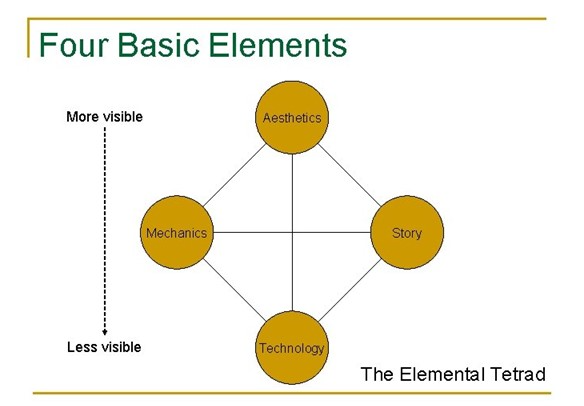Game Frameworks
Popular Frameworks
While there have been several attempts at defining this framework, the most widely cited frameworks include:
MDA :Mechanics, Dynamics, Aesthetics (Robin Hunicke, Mark Leblanc, and Robert Zubek)
Elemental Tetrad :Mechanics, Aesthetics, Story and Technology (Jesse Schell)
Formal, Dramatic, Dynamic Elements (Tracy Fullerton and Chris Swain)
MDA Framework
The MDA framework breaks apart a game into the following categories
- Mechanics describes the components of the game, at the level of data representation and algorithms. (ie. The Rules for the game)
- Dynamics describes the run-time behavior of the mechanics acting on player inputs and each others' outputs over time. (ie. How the game is played)
- Aesthetics describes the desirable emotional responses evoked in the player when she interacts with the game system (ie. The player experience)
According to the MDA framework designers and players view games from different directions. Far too often designers start with the mechanics of a game (what do we know how to build) instead of considering the aesthetics (what the player should experience).
MDA framework designers should first approach a game by deciding on the player experience (aesthetics) and then work backward to create the dynamics and mechanics that fit the chosen aesthetics.

Elemental Tetrad
Jesse Schell extended upon an revised the MDA by additionally looking at technology and story. Schell arranges these elements into a tetrad which shows how all elements interrelate to each other and to which are most visible to the player.
These elements include:
- Mechanics :rules for interaction
- Aesthetics :how the game is perceived by the senses.
- Technology: the underlying technology that makes the game work
- Story :all dramatic elements of a game, not just "story" but the characters, premise, challenge, and play

Formal, Dramatic, Dynamic Elements
Developed by Tracy Fullerton and Chris Swain the Formal, Dramatic and Dynamic elements were designed to help game design students by further breaking down the individual elements of a game.
Formal elements are the elements that provide the basic game mechanics. Without these elements, the game would not function and be ultimately unplayable.
The formal elements include:
- Players :individuals playing the game
- Objectives or Goals :what the player must strive to accomplish
- Procedures :steps to playing the game
- Rules :what the player can and cannot do
- Resources :game assets that aid the player
- Conflict :the obstacles that the player encounters
- Boundaries :the limitations to what the player can do
- Outcomes :a winner, looser or draw
The dramatic elements of a game are what engage the player emotionally and keep the player invested in playing the game. These elements include:
- Challenge :creates tension for the player
- Play :the ability for players to play (mess about) within the game system, bending the rules sort of speak.
- Premise :the concept behind the game story. Some games only have a premise
- Story :takes the premise further and enriches the game experience
- Characters :provide players a way to empathize with the story
Dynamic elements are those that occur only when the game is being played.
- Emergence :simple rules that can lead to unexpected outcomes based on the player's actions. The player may do things that were unanticipated by the designer and may result in these unexpected outcomes.
- Emergent Narratives :a narrative that is not written into the game but emerges from the player's interactions with other players and the game systems.
- Playtesting :playtesting reveals information about the various dynamic behaviors that a game could have and helps designers understand the range of experiences that could be generated by their game.
Game systems are the set of interacting or interdependent elements forming the working game. These elements work with this closed system, engaging players in structured conflict and resolving its uncertainty in an unequal outcome.
When thinking about the elements of games remember that games are given structure by their formal elements and emotionally engage the player by their dramatic elements.
There are a few other requirements in games that do not specifically fall into the formal or dramatic elements list. These are not individual items in the game, but rather a sub-system that works inside the game.
MED Framework
While each of the described frameworks provides a different perspective for understanding games. No one framework is universally followed.
With that said, Computer Simulation and Gaming Professor Akram Taghavi-Burris, has developed the MED framework as a combination and expansion of ideas presented in all of the previous frameworks. The MED framework consists of:
- Game Mechanics refers to the elements that make the game functional
- Player Engagement refers to the elements that make the player want to play the game
- Game Dynamics refers to the overall system and how it can be influenced by the mechanics and the players
You can also look at these classifications:
- How :how does the game work
- Why :why should the player be playing
- What :what happens during gameplay